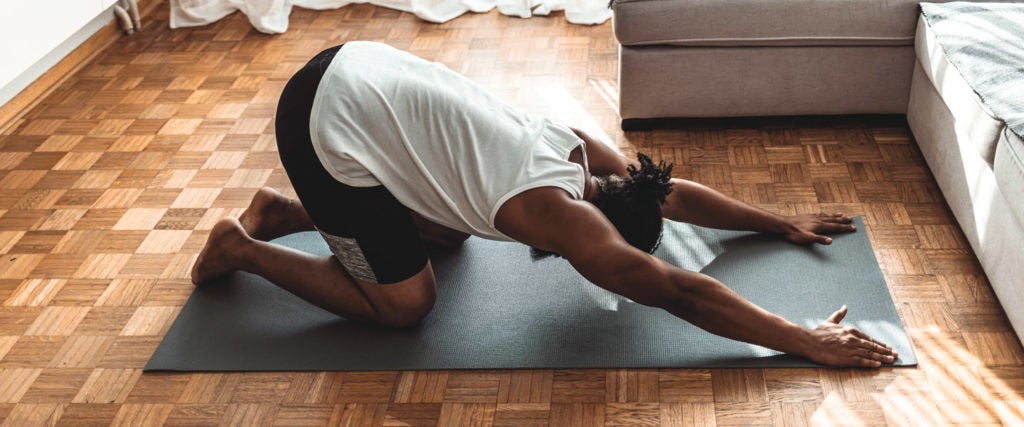Intuitive eating has always been something that made sense to me. As someone who grew up with I Can’t Believe It’s Not Butter spray and consumed a troubling amount of Aspartame for a child, I’ve gone the opposite way as an adult — I believe all diets are inherently bad and that living a food-obsessed life is much worse for my mental and physical health than just giving my body the nutrients it needs, even if I occasionally screw up and eat a bag of Cheetos like a barnyard animal.
But when I heard about intuitive movement as an emerging fitness trend, I had the opposite reaction. The idea of listening to my body about what I should eat is one thing, but putting it in charge of how I workout? What is there to stop me from laying on the couch smoking weed and calling it yoga? After all, it’s not not yoga.
The more I read about the practice, the more it intuitively smelled like a bunch of bullshit, until I called up psychologist and yoga instructor Lindsay Weisner, who was able to break down the purpose of intuitive movement and intuitive exercise. For starters, intuitive movement was originally a form of physical therapy used for seniors and individuals with special needs, but thanks to the rise of intuitive eating, it’s become a part of a bigger backlash to more rigid and restrictive wellness trends. Still, when you consider the fact that exercise, by definition, is the practice of putting stress on the body to make it stronger, the idea of intuitive exercise seems like an oxymoron.
Weisner concedes that, as intuitive movement becomes increasingly popular, the definition of what it means has become muddier. No one really knows how much they should listen to their bodies, especially after how much trouble it got them into in their 20s.
“You’re really counting on a person to know what’s best for them,” Weisner points out. For instance, intuitive eating is a recovery goal for people with eating disorders, but if a person struggling with bulimia tried to eat intuitively without getting any professional help, their intuition would likely be to binge and purge. People need tools to distinguish between their body’s needs and the psyche’s unhealthy impulses, and not everyone has those tools. Because of this, “there should be rules for some things,” Weisner warns. “Otherwise we’re setting people up for extremes — either total laziness or a lot of injuries, over exercising and disordered behaviors.”
To be fair, learning to exercise in a more intuitive way can be useful, but mostly for people who work out a lot already. “If I’m already a gym rat, working out intuitively makes sense because I’m particularly aware of my strengths and limits,” Weisner tells me. At the moment, most of the people talking about intuitive exercise are yogis and trainer-types who can be trusted to listen to their bodies, so that’s fine. But as intuitive movement becomes more mainstreamed, the rest of us might need to put someone else in charge.
Even as a yogi, Weisner admits her exercise intuition was off the afternoon we spoke. Due to a stressful day, she worked out twice and jogged four-miles each time. “Intuitively that was what I thought I needed, but I have three herniated discs and my back is going to hurt like hell tomorrow,” she says. “I probably should’ve done yoga.”
Ultimately, whether or not intuitive movement is good, or even exercise, comes down to an individual’s self-awareness about how they use it. Instead of using intuitive movement as an excuse to smoke weed on the couch or run eight miles with a bad back, Weisner recommends using it as more of a casual fitness philosophy. For instance, set goals for how many days you want to workout a week and for how long, but wait to decide if you feel like doing this in the morning, evening or break up a long workout into two or three smaller ones throughout the day. If you’re bored and plateauing with a workout routine, intuitively decide to dip your toe into an exercise that’s more outside of your comfort zone, like ballet.
For people who have trouble figuring out what to do on their rest days, it’s helpful to think of intuitive movement as “active recovery” — or low intensity exercises like walking, swimming and yoga that can help swole guys maximize their gains with adequate rest. Finally, when you’re challenging yourself, intuitive movement is that important inner “fuck no” that can keep you from potentially getting hurt.
“There’s a component to intuitive movement that we should embrace, which is if it doesn’t feel right, don’t do it. Also, Orangetheory [an intense HIIT workout known for pushing participants by posting their results on a leaderboard] should burn in hell,” Weisner jokes. She notes that although the fitness chain provides adjustments, the extreme standard set by this workout isn’t for everybody, nor should it be. “But if you were using intuitive movement, you’d be able to say, ‘No, this doesn’t feel right for my body. I have a bad ankle, I’m not going to do this.’”
Given how much I miss crushing a peppy fitness instructor’s spirit with a hard “absolutely not,” this is the one part of intuitive movement I can fully get behind.

